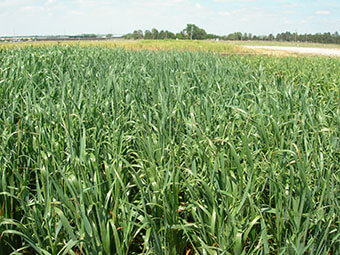Nitrate Toxicity in Ruminants
Oct 14, 2019

Several regions of the state are experiencing varying degrees of drought. This may increase the chances for accumulation of nitrates in plants. Plants highly susceptible to nitrate accumulation are corn, oats, millet, sorghum-sudan, and wheat.
Accumulation of Nitrates by Plants
Nitrate accumulation occurs when the uptake of soil nitrates continues even as plant photosynthesis and carbohydrate and protein synthesis cease. Factors that contribute to the accumulation of nitrates in plants include:
Plant part Nitrate-Nitrogen (ppm)
Ears 17
Leaves 64
Upper 1/3 stalk 153
Middle 1/3 stalk 803
Lower 1/3 stalk 5524
Whole plant 978
Table 1. Nitrate-Nitrogen content of drought-stressed corn plant1
Effects of Nitrates on Animals
Animals experiencing nitrate toxicity will exhibit several characteristic symptoms, including:
Alleviation of Nitrate Toxicity
Animals diagnosed with nitrate toxicity may require immediate attention. Because their blood’s capacity to carry oxygen is severely reduced, care should be taken in handling these animals for treatment. Exciting the animal may cause respiratory failure and death.
Treatment of nitrate toxicity consists of an intravenous solution of 1% Methylene blue at the rate of 4 mg/lb. bodyweight, following in 30 minutes by a second dose. Methylene blue converts methemoglobin back to hemoglobin. Diagnosis and treatment of nitrate toxicity should be performed by a licensed veterinarian.
Prevention Of Nitrate Toxicity
When conditions exist that may lead to accumulations of nitrates in forages, they should be tested for nitrate concentrations. Testing should be performed before the first use of the forage to avoid potential problems. Nitrate testing at our laboratory is $20 when samples are sent in for nitrate testing alone.
Forages should be tested annually and whenever there is a change in harvesting dates. Conditions that add to nitrate accumulation could have occurred between harvesting dates, resulting in different nitrate levels.
The following guidelines are also recommended to prevent nitrate toxicity:
5. Complete silo fermentation requires up to 21 days. Producers feeding out of silos as they
are filling them must be cautious about gases and levels of NO3 in feed.
6. Analyze feeds for nitrate prior to feeding.
Accumulation of Nitrates by Plants
Nitrate accumulation occurs when the uptake of soil nitrates continues even as plant photosynthesis and carbohydrate and protein synthesis cease. Factors that contribute to the accumulation of nitrates in plants include:
- Drought (more so in mild drought conditions)
- Frost
- Low light intensities
- Low temperatures
- Nutrient deficiencies
- Excess nitrogen fertilization
- Plant disease
Plant part Nitrate-Nitrogen (ppm)
Ears 17
Leaves 64
Upper 1/3 stalk 153
Middle 1/3 stalk 803
Lower 1/3 stalk 5524
Whole plant 978
Table 1. Nitrate-Nitrogen content of drought-stressed corn plant1
Effects of Nitrates on Animals
Animals experiencing nitrate toxicity will exhibit several characteristic symptoms, including:
- Hypoxia (blueish-gray color) of mucous membranes
- Muscular weakness
- Rapid, weak heartbeat
- Low blood pressure
- Low body temperature
- Fast, labored breathing
- Abortions
Alleviation of Nitrate Toxicity
Animals diagnosed with nitrate toxicity may require immediate attention. Because their blood’s capacity to carry oxygen is severely reduced, care should be taken in handling these animals for treatment. Exciting the animal may cause respiratory failure and death.
Treatment of nitrate toxicity consists of an intravenous solution of 1% Methylene blue at the rate of 4 mg/lb. bodyweight, following in 30 minutes by a second dose. Methylene blue converts methemoglobin back to hemoglobin. Diagnosis and treatment of nitrate toxicity should be performed by a licensed veterinarian.
Prevention Of Nitrate Toxicity
When conditions exist that may lead to accumulations of nitrates in forages, they should be tested for nitrate concentrations. Testing should be performed before the first use of the forage to avoid potential problems. Nitrate testing at our laboratory is $20 when samples are sent in for nitrate testing alone.
Forages should be tested annually and whenever there is a change in harvesting dates. Conditions that add to nitrate accumulation could have occurred between harvesting dates, resulting in different nitrate levels.
The following guidelines are also recommended to prevent nitrate toxicity:
- When plants receive rain after an extended period of drought, delay pasturing animals or harvesting crop for four to five days.
- As seen in Table 1, nitrates tend to accumulate in the lower 1/3 portion of the stalk. Cut suspected forages higher up the stalk to avoid the portions containing higher nitrate levels .
- Dried forages are more toxic than green harvested or pastured forages because dried forages release up to 80 percent of their nitrate into ruminal fluid within 20 minutes after feeding. Wet forages only release 30% of their nitrate.
- Ensiling high nitrate reduces levels 30 to 60%. Fermentation produces toxic nitrogen gas, which is heavier than air and settles at the bottom of silos. Turn silo blower on for 10 minutes prior to working in silo area.
5. Complete silo fermentation requires up to 21 days. Producers feeding out of silos as they
are filling them must be cautious about gases and levels of NO3 in feed.
6. Analyze feeds for nitrate prior to feeding.
- Feed a balanced ration. Nitrates in the rumen are reduced to ammonia and will contribute to the NPN and soluble protein portions of the ration.
- Use iodized salt when high nitrate feeds are fed.
- Fortify the vitamin A concentration of the ration
- Increase the concentration portion of the diet or blend a low nitrate forage into the diet. This will dilute nitrate intake and reduce toxicity.